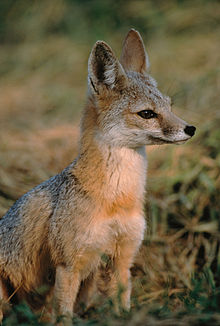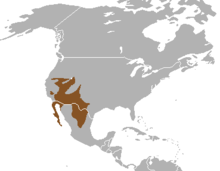- Kit fox
-
For other uses, see Kit (disambiguation).
Kit fox[1] 
San Joaquin kit fox Conservation status Scientific classification Kingdom: Animalia Phylum: Chordata Class: Mammalia Order: Carnivora Family: Canidae Genus: Vulpes Species: V. macrotis Binomial name Vulpes macrotis
Merriam, 1888
Kit fox range Synonyms - arizonensis Goldman, 1931
- arsipus Elliot, 1904
- devius Nelson and Goldman, 1909
- muticus Merriam, 1902
- neomexicanus Merriam, 1903
- nevadensis Goldman, 1931
- tenuirostris Nelson and Goldman, 1931
- zinseri Benson, 1938
The kit fox (Vulpes macrotis) is a fox species of North America. Its range is primarily in the southwestern United States and northern and central Mexico. Some mammalogists classify it as conspecific with the swift fox, V. velox, but molecular systematics imply that the two species are distinct.
Contents
Range
The northernmost part of its range is the arid interior of Oregon. Its eastern limit is southwestern Colorado. It can be found south through Nevada, Utah, southeastern California, Arizona, New Mexico, and into western Texas.[3]
Appearance
The kit fox is the smallest species of the Canidae family that can be found in North America. They have large ears, between 71–95 mm (2.8–3.75 in), that help the fox lower its body temperature and give it exceptional hearing. This species exhibits sexual dimorphism, with the male being slightly larger. The average species weight is between 1.6–2.7 kg (3.5–6 lbs). The body length is 455 to 535 mm (18 to 21 in). The tail adds another 250–340 mm (9.85–13.4 in) to their length.[3]
It usually has a gray coat, with rusty tones, and a black tip to its tail. Unlike the gray fox, it has no stripe along the length of its tail. Their color ranges from yellowish to gray. Their back is usually darker than the majority of their coat, and their belly and inner ears are usually lighter. They have distinct dark patches around the nose.[3]
Diet
The Kit fox is mostly a nocturnal animal but sometimes ventures out of its den during the day. The Kit fox usually goes out to hunt shortly after sunset, mostly eating small animals such as kangaroo rats, cottontail rabbits, black-tailed jackrabbits (Lepus californicus), meadow voles, hares, prairie dogs, insects, lizards, snakes, fish, and ground-dwelling birds. They will scavenge carrion. While primarily carnivorous, if food is scarce, they have been known to eat tomatoes (Lycopersicon esculentum), cactus fruits (Carnegiea gigantea) and other fruits. Different Kit fox families can occupy the same hunting grounds, but do not generally go hunting at the same time.[3]
Habitat
Kit foxes favor arid climates, like desert scrub, chaparral, and grasslands. Good examples of common habitats are sagebrush Artemisia tridentata and saltbrush Atriplex polycarpa. They can be found in urban and agricultural areas, too. They are found between elevations of 400 to 1,900 meters (1,300 to 6,200 feet).[3]
Mating
Male and female kit foxes usually establish monogamous mating pairs during October and November. Polygamous mating relationships have been observed. Pairs can change year to year. They mate from December to February, when they use larger family dens.[clarification needed] Litters are born throughout March and April, usually containing 1 to 7 pups, and averaging 4 pups. The gestation is 49 to 55 days. Pups do not leave the den until they are 4 weeks old. They are weaned after about 8 weeks and become independent at 5 to 6 months old. They become sexually mature at 10 months. Both parents take part in raising and protecting their young. The average lifespan of a wild kit fox is 5.5 years. In captivity, they can live 12 years. One California study of 144 kit fox pups showed a 74% mortality rate in pups within the first year.[4][3]
Subspecies
The Kit fox has no recognized subspecies, although some populations have been proposed as subspecies.[1]
The San Joaquin kit fox (Vulpes macrotis mutica) was formerly common in the San Joaquin Valley of California. Its 1990 population was estimated to be 7,000, and it is now considered endangered. On September 26, 2007, Wildlands Inc. announced the designation of the 684-acre (2.77 km2) Deadman Creek Conservation Bank, which is intended specifically to protect habitat of the San Joaquin Kit fox.[5] Causes of population declines include heavy competition with the red fox and habitat loss.
The desert kit fox (Vulpes macrotis arsipus) lives in the Mojave Desert.
The Southern California kit fox (Vulpes macrotis macrotis) was a population of kit foxes native to desert regions of Southern California which became extinct in 1903.
References
- ^ a b Wozencraft, W. Christopher (16 November 2005). "Order Carnivora (pp. 532-628)". In Wilson, Don E., and Reeder, DeeAnn M., eds. Mammal Species of the World: A Taxonomic and Geographic Reference (3rd ed.). Baltimore: Johns Hopkins University Press, 2 vols. (2142 pp.). ISBN 978-0-8018-8221-0. OCLC 62265494. http://www.bucknell.edu/msw3/browse.asp?id=14000878.
- ^ IUCN SCC Canid Specialist Group (North America Regional Section) (2008). Vulpes macrotis. In: IUCN 2008. IUCN Red List of Threatened Species. Downloaded on 22 March 2009. Database entry includes a brief justification of why this species is of least concern
- ^ a b c d e f ADW: Vulpes macrotis: Information. Animaldiversity.ummz.umich.edu (2008-04-05). Retrieved on 2011-09-16.
- ^ "Kit Fox (Vulpes macrotis): A Technical Conservation Assessment", 2006
- ^ Kit fox Gets Some Protection, In California, Environmental News Network, September 27, 2007
External links
Categories:- IUCN Red List least concern species
- Foxes
- Fauna of Mexico
- Fauna of Northern Mexico
- Mammals of the United States
- Fauna of the Western United States
Wikimedia Foundation. 2010.

